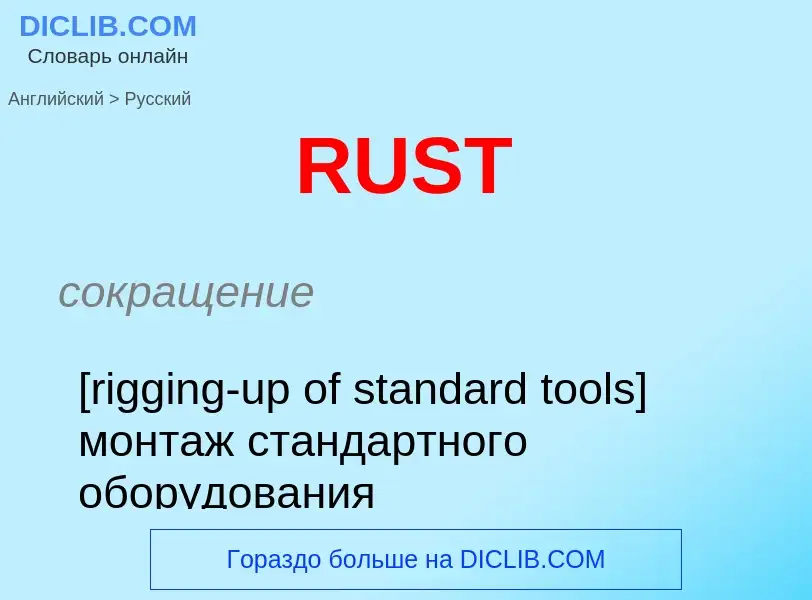Перевод и анализ слов искусственным интеллектом ChatGPT
На этой странице Вы можете получить подробный анализ слова или словосочетания, произведенный с помощью лучшей на сегодняшний день технологии искусственного интеллекта:
- как употребляется слово
- частота употребления
- используется оно чаще в устной или письменной речи
- варианты перевода слова
- примеры употребления (несколько фраз с переводом)
- этимология
rust - перевод на русский
сокращение
[rigging-up of standard tools] монтаж стандартного оборудования
[rʌst]
общая лексика
ржавчина (возбудитель - ржавчинный гриб)
быть поражённым ржавчиной
страдать от ржавчины (о растениях)
ржавчинный гриб
защитный
коррозия
противокоррозийный
ржаветь
ржавый
Смотрите также
существительное
[rʌst]
общая лексика
ржавчина
коррозия металла
цвет ржавчины
вредное влияние или последствия (безделья и т. п.)
ослабление памяти
понижение умственных способностей (от старости и т. п.)
ржавчина (болезнь растений)
глагол
общая лексика
ржаветь
покрываться ржавчиной
подвергать коррозии
притуплять
ослаблять (память, ум)
томиться от безделья
прозябать
быть поражённым ржавчиной
страдать от ржавчины (о растениях)
приобретать цвет ржавчины
порыжеть
выцвести
ржаветь, покрываться ржавчиной
портиться, притупляться (от бездействия)
быть пораженным ржавчиной (о растениях)
Определение
Википедия

Rust is an iron oxide, a usually reddish-brown oxide formed by the reaction of iron and oxygen in the catalytic presence of water or air moisture. Rust consists of hydrous iron(III) oxides (Fe2O3·nH2O) and iron(III) oxide-hydroxide (FeO(OH), Fe(OH)3), and is typically associated with the corrosion of refined iron.
Given sufficient time, any iron mass, in the presence of water and oxygen, could eventually convert entirely to rust. Surface rust is commonly flaky and friable, and provides no passivational protection to the underlying iron, unlike the formation of patina on copper surfaces. Rusting is the common term for corrosion of elemental iron and its alloys such as steel. Many other metals undergo similar corrosion, but the resulting oxides are not commonly called "rust".
Several forms of rust are distinguishable both visually and by spectroscopy, and form under different circumstances. Other forms of rust include the result of reactions between iron and chloride in an environment deprived of oxygen. Rebar used in underwater concrete pillars, which generates green rust, is an example. Although rusting is generally a negative aspect of iron, a particular form of rusting, known as stable rust, causes the object to have a thin coating of rust over the top. If kept in low relative humidity, it makes the "stable" layer protective to the iron below, but not to the extent of other oxides such as aluminium oxide on aluminium.



![Rust and dirt on the surface of a [[sheet pan]]. Rust and dirt on the surface of a [[sheet pan]].](https://commons.wikimedia.org/wiki/Special:FilePath/Rust and dirt.jpg?width=200)
![Outdoor ''Rust Wedge'' at the [[Exploratorium]] showing the expansion of rusting iron Outdoor ''Rust Wedge'' at the [[Exploratorium]] showing the expansion of rusting iron](https://commons.wikimedia.org/wiki/Special:FilePath/Rust wedge.jpg?width=200)
![Heavy rust on the links of a chain near the [[Golden Gate Bridge]] in [[San Francisco]]; it was continuously exposed to moisture and [[salt spray]], causing surface breakdown, cracking, and flaking of the metal Heavy rust on the links of a chain near the [[Golden Gate Bridge]] in [[San Francisco]]; it was continuously exposed to moisture and [[salt spray]], causing surface breakdown, cracking, and flaking of the metal](https://commons.wikimedia.org/wiki/Special:FilePath/RustyChainEdit1.jpg?width=200)
![Rust scale forming and flaking off from a steel bar heated to its [[forging]] temperature of 1200°C. Rapid oxidation occurs when heated steel is exposed to air Rust scale forming and flaking off from a steel bar heated to its [[forging]] temperature of 1200°C. Rapid oxidation occurs when heated steel is exposed to air](https://commons.wikimedia.org/wiki/Special:FilePath/Trabajando una pieza de metal al rojo sobre un yunque.jpg?width=200)
![The collapsed [[Silver Bridge]], as seen from the [[Ohio]] side The collapsed [[Silver Bridge]], as seen from the [[Ohio]] side](https://commons.wikimedia.org/wiki/Special:FilePath/Silver Bridge collapsed, Ohio side.jpg?width=200)
![The [[Kinzua Bridge]] after it collapsed The [[Kinzua Bridge]] after it collapsed](https://commons.wikimedia.org/wiki/Special:FilePath/Collapsed Kinzua Bridge.jpg?width=200)
![pitted]] struts of the 70-year-old [[Nandu River Iron Bridge]] pitted]] struts of the 70-year-old [[Nandu River Iron Bridge]]](https://commons.wikimedia.org/wiki/Special:FilePath/Nandu River Iron Bridge corrosion - 03.jpg?width=200)
![Rusting [[rebar]] has expanded and [[spall]]ed concrete off the surface of this [[reinforced concrete]] support Rusting [[rebar]] has expanded and [[spall]]ed concrete off the surface of this [[reinforced concrete]] support](https://commons.wikimedia.org/wiki/Special:FilePath/Qew bruecke nf beton kaputt 23 von 46.jpg?width=200)
